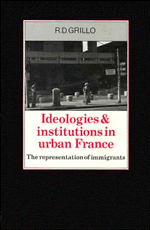Book contents
- Frontmatter
- Contents
- List of tables, figures, and maps
- Acknowledgments
- Glossary of abbreviations and acronymns
- 1 Introduction
- 2 Immigrants in France and in Lyon
- 3 Two modes of discourse: immigrés and étrangers
- 4 Urban development and the problems of housing: the “bachelors”
- 5 Housing and the “problems” of immigrant families
- 6 North African women and the French social services
- 7 In the schools and on the streets
- 8 Language
- 9 Work
- 10 “The strike is like a school”
- 11 The representation of problems and the problem of representation
- 12 Conclusion: institutional and ideological structures
- Appendix: The French school system
- Bibliography
- Maps
- Index
1 - Introduction
Published online by Cambridge University Press: 27 August 2009
- Frontmatter
- Contents
- List of tables, figures, and maps
- Acknowledgments
- Glossary of abbreviations and acronymns
- 1 Introduction
- 2 Immigrants in France and in Lyon
- 3 Two modes of discourse: immigrés and étrangers
- 4 Urban development and the problems of housing: the “bachelors”
- 5 Housing and the “problems” of immigrant families
- 6 North African women and the French social services
- 7 In the schools and on the streets
- 8 Language
- 9 Work
- 10 “The strike is like a school”
- 11 The representation of problems and the problem of representation
- 12 Conclusion: institutional and ideological structures
- Appendix: The French school system
- Bibliography
- Maps
- Index
Summary
The ethnography on which this monograph is based derives from an anthropological study, undertaken in 1974–6, of immigrants, mainly of North African origin, living in a French provincial city. This book is, however, only partly concerned with such immigrants, and it has not been conceived in any straightforward way as a contribution to migration studies.
The discussion moves on three levels, or to put it less pretentiously, approaches the data from three directions, each leading toward a somewhat different, if ultimately related, range of analytical problems. The implications of “level,” which suggests differences of depth, subtlety, and perhaps sophistication, are not, however, wholly misleading, in that each raises problems of greater generality within the social sciences and greater complexity, at least for this analyst. They also represent phases in the analyst's perception of his ethnography. We are rarely told so, but it is usual in anthropology, as in other disciplines, for the researcher to move through many stages in understanding a society in which intensive fieldwork has been undertaken. This occurs in the field itself and, in the aftermath, in the writing. In a sense, the process never stops, even after, perhaps especially after, results have been published. The anthropologist's material is not something in which one can find a final, conclusive answer, any more than one can with a painting or a piece of music. If we are honest, any anthropological publication is a report on analysis in progress; and this is no exception.
- Type
- Chapter
- Information
- Ideologies and Institutions in Urban FranceThe Representation of Immigrants, pp. 1 - 28Publisher: Cambridge University PressPrint publication year: 1985

